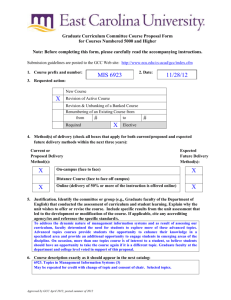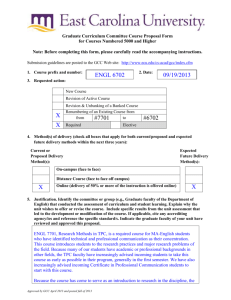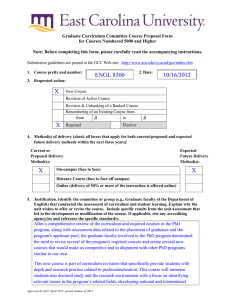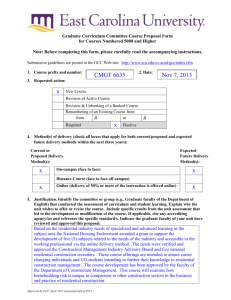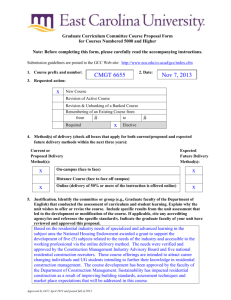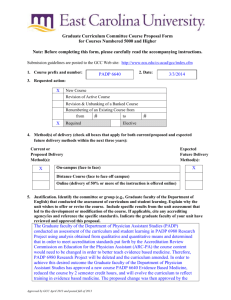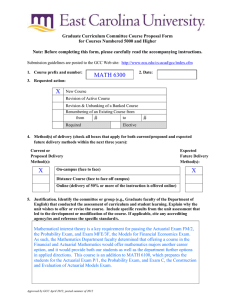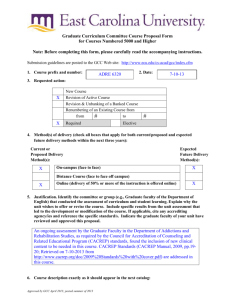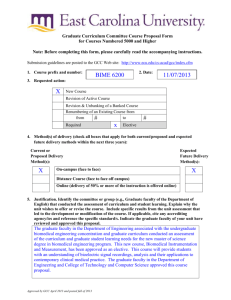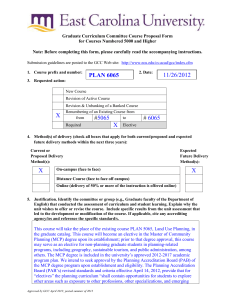Revision
advertisement
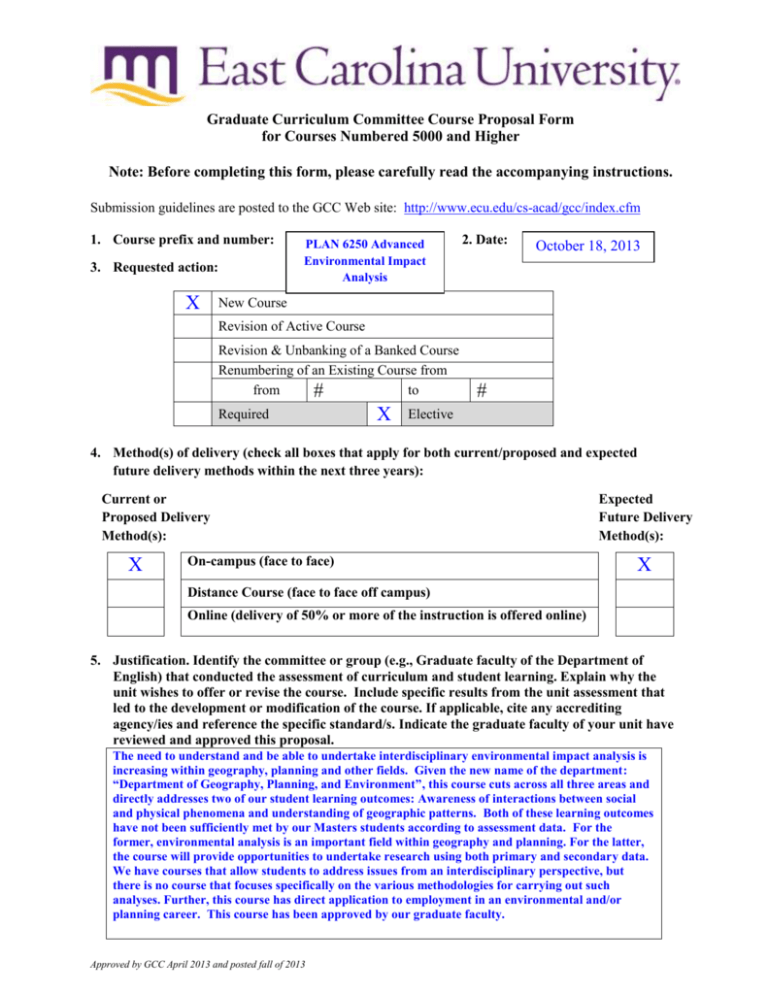
Graduate Curriculum Committee Course Proposal Form for Courses Numbered 5000 and Higher Note: Before completing this form, please carefully read the accompanying instructions. Submission guidelines are posted to the GCC Web site: http://www.ecu.edu/cs-acad/gcc/index.cfm 1. Course prefix and number: 3. Requested action: X PLAN 6250 Advanced Environmental Impact Analysis 2. Date: October 18, 2013 New Course Revision of Active Course Revision & Unbanking of a Banked Course Renumbering of an Existing Course from from to # Required X # Elective 4. Method(s) of delivery (check all boxes that apply for both current/proposed and expected future delivery methods within the next three years): Current or Proposed Delivery Method(s): X On-campus (face to face) Expected Future Delivery Method(s): X Distance Course (face to face off campus) Online (delivery of 50% or more of the instruction is offered online) 5. Justification. Identify the committee or group (e.g., Graduate faculty of the Department of English) that conducted the assessment of curriculum and student learning. Explain why the unit wishes to offer or revise the course. Include specific results from the unit assessment that led to the development or modification of the course. If applicable, cite any accrediting agency/ies and reference the specific standard/s. Indicate the graduate faculty of your unit have reviewed and approved this proposal. The need to understand and be able to undertake interdisciplinary environmental impact analysis is increasing within geography, planning and other fields. Given the new name of the department: “Department of Geography, Planning, and Environment”, this course cuts across all three areas and directly addresses two of our student learning outcomes: Awareness of interactions between social and physical phenomena and understanding of geographic patterns. Both of these learning outcomes have not been sufficiently met by our Masters students according to assessment data. For the former, environmental analysis is an important field within geography and planning. For the latter, the course will provide opportunities to undertake research using both primary and secondary data. We have courses that allow students to address issues from an interdisciplinary perspective, but there is no course that focuses specifically on the various methodologies for carrying out such analyses. Further, this course has direct application to employment in an environmental and/or planning career. This course has been approved by our graduate faculty. Approved by GCC April 2013 and posted fall of 2013 6. Course description exactly as it should appear in the next catalog: PLAN 6250 – Advanced Environmental Impact Analysis 3 Same as GEOG 6250 C: GEOG 6251. Theory and techniques of environmental analysis. Environmental impact statements: what they are, how they came into being, their role in environmental decision making. 7. If this is a course revision, briefly describe the requested change: 8. Course credit: Lecture Hours 3 3 Weekly OR Per Term Credit Hours Lab Weekly OR Per Term Credit Hours s.h. Studio Weekly OR Per Term Credit Hours s.h. Practicum Weekly OR Per Term Credit Hours s.h. Internship Weekly OR Per Term Credit Hours s.h. Other (e.g., independent study) Please explain. s.h. 3 Total Credit Hours 9. Anticipated annual student enrollment: 8 10. Changes in degree hours of your programs: Degree(s)/Program(s) Changes in Degree Hours None 11. Affected degrees or academic programs, other than your programs: Degree(s)/Program(s) Changes in Degree Hours None 12. Overlapping or duplication with affected units or programs: Not applicable of notification to the affected academic degree programs is X Documentation attached. Approved by GCC April 2013 and posted fall of 2013 s.h. s.h. 13. Council for Teacher Education (CTE) approval (for courses affecting teacher education): X Not applicable Applicable and CTE has given their approval. 14. Service Learning Committee (SLC) approval: X Not applicable Applicable and SLC has given their approval. 15. Statements of support: a. Staff X Current staff is adequate Additional staff is needed (describe needs in the box below): b. Facilities X Current facilities are adequate Additional facilities are needed (describe needs in the box below): c. Library X Initial library resources are adequate Initial resources are needed (in the box below, give a brief explanation and an estimate for the cost of acquisition of required initial resources): d. Unit computer resources X Unit computer resources are adequate Additional unit computer resources are needed (in the box below, give a brief explanation and an estimate for the cost of acquisition): e. ITCS resources X ITCS resources are not needed The following ITCS resources are needed (put a check beside each need): Mainframe computer system Statistical services Network connections Computer lab for students Software Approval from the Director of ITCS attached 16. Course information (see: Graduate Curriculum and Program Development Manual for instructions): a. Textbook(s) and/or readings: author(s), name, publication date, publisher, and city/state/country. Include ISBN (when applicable). Readings: The National Environmental Policy Act (http://ceq.hss.doe.gov/laws_and_executive_orders/the_nepa_statute.html) Approved by GCC April 2013 and posted fall of 2013 Benson, M.H. and A.S. Garmestani. 2011. Embracing panarchy, building resilience and integrating adaptive management through a rebirth of the National Environmental Policy Act. Journal of Environmental Management 92(5): 1420-1427. Council on Environmental Quality. 1986. Regulations for Implementing the Procedural Provisions of NEPA, 40 CFR Parts 1500-1508 Mandelker, D.R. 2010. National Environmental Policy Act: a review of its experience and problems. Washington University Journal of Law and Policy 32: 293-312. Tzoumis, K. 2007. Comparing the quality of draft environmental impact statements by agencies in the United States since 1998 to 2004. Environmental Impact Assessment Review 27: 26-49. Slotterback, C.S. 2009. Scoping implementation in National Environmental Policy Act processes in US transportation agencies. Transportation Research Part D: Transport and Environment 14(2): 8390. Cashmore, M., A. Bond, and D. Cobb. 2007.The contribution of environmental assessment to sustainable development: toward a richer empirical understanding. Environmental Management 40: 516-530. Salk, M.S., V.R. Tolbert, and J.A. Dickerman. 1999. Guidelines and techniques for improving the NEPA process. Environmental Management 23(4): 467-476. Lawrence, David P. 2007. Impact significance determination – designing an approach. Environmental Impact Assessment Review 27: 730-754. Wood, G. 2008. Thresholds and criteria for evaluating and communicating impact significance in environmental statements: ’See no evil, hear no evil, speak no evil’? Environmental Impact Assessment Review 28: 22-38. Eccleston, C.H. 2010. Assessing cumulative significance of greenhouse gas emissions: resolving the paradox—the Sphinx Solution. Environmental Practice 12(2): 105-115. O’Faircheallaigh, C. 2009. Effectiveness in social impact assessment: Aboriginal peoples and resource development in Australia. Impact Assessment and Project Appraisal 27(2): 95-110. Bjorkland, Ronald. 2013. Monitoring: the missing piece: a critique of NEPA monitoring. Environmental Impact Assessment Review 43 (November): 129-134. Ma, Z., D.R. Becker and M.A. Kilgore. 2009. Characterising the landscape of state environmental review policies and procedures in the United States: a national assessment. Journal of Environmental Planning and Management 52(8):1035-1051. b. Course objectives for the course (student – centered, behavioral focus) If this is a 5000-level course that is populated by undergraduate and graduate students, there must be differentiation in the learning objectives expected. Upon completion of this course, students will be able to: 1. 2. Prepare interdisciplinary environmental analyses Identify proposed actions that require environmental impact analysis Approved by GCC April 2013 and posted fall of 2013 3. 4. 5. 6. Identify and collect appropriate data to carry out an environmental impact analysis Differentiate the appropriate interdisciplinary methods for analysis of a project Evaluate the environmental impact of a project Evaluate the role of environmental impact analysis in both public and private planning contexts. c. Course topic outline The list of topics should reflect the stated objectives. Introduction; the National Environmental Policy Act and EISs Regulations for EIS preparation Evaluating EIS Adequacy Steps in the process – an overview Screening and Scoping; Determining appropriate alternatives Interdisciplinary and Multi-disciplinary Science Data needs for environmental impact analysis Methods of Impact Analysis Cumulative Impact Assessment Social Impact Assessment Environmental justice and environmental impact analysis Public participation Monitoring d. List of course assignments, weighting of each assignment, and grading/evaluation system for determining a grade Exam EIS critique 25% 25% Approved by GCC April 2013 and posted fall of 2013 EIS presentation Written EIS Class Participation 10% 30% 10% A = 90-100 B = 80-89 C = 70-79 F = Below 70 Approved by GCC April 2013 and posted fall of 2013
